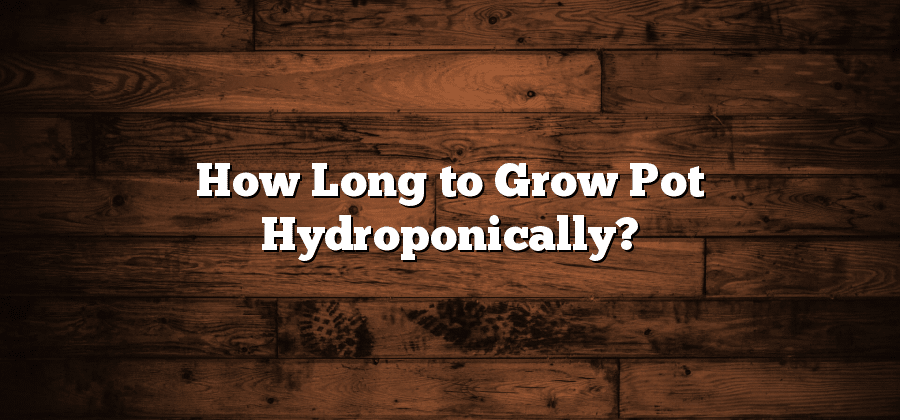Understanding the Growth Cycle of Hydroponic Marijuana
Hydroponic marijuana cultivation offers a controlled and efficient method for growing cannabis plants. Understanding the growth cycle of hydroponic marijuana is essential for achieving optimal yields and high-quality buds. This growth cycle can be divided into distinct stages: germination, vegetative stage, and flowering stage.
During the germination stage, seeds begin to sprout and develop roots. To ensure successful germination, it is crucial to provide the right temperature, humidity, and moisture levels. The use of a germination medium, such as rockwool cubes or peat pots, helps maintain moisture around the seeds and provides a stable environment for root development. Once the seeds have sprouted, they can be transplanted into the hydroponic system, where they will move into the vegetative stage.
Optimal Conditions for Hydroponic Pot Growth
For hydroponic pot growth, creating and maintaining optimal conditions is crucial to ensure the plants thrive and produce high-quality yields. One important factor to consider is the temperature. Ideally, the temperature should be kept between 70-75 degrees Fahrenheit during the day and slightly cooler, around 65-70 degrees Fahrenheit, during the night. This temperature range promotes proper photosynthesis and metabolic processes within the plants, leading to healthy growth.
In addition to temperature, humidity levels also play a significant role in the optimal conditions for hydroponic pot growth. The ideal humidity range during the vegetative stage is around 50-70%, while during the flowering stage, it should be slightly lower, between 40-50%. Maintaining appropriate humidity levels helps in preventing mold and fungal growth, while also aiding in nutrient absorption by the plants’ roots. Adequate air circulation and ventilation systems can help regulate humidity levels and ensure a favorable environment for the plants.
By maintaining the right temperature and humidity levels, hydroponic pot growers can create optimal conditions for their plants to flourish. However, it is important to note that every strain may have its specific requirements, so it’s essential to research and tailor the conditions accordingly. Moving forward, let us now delve into the essential stages of hydroponic marijuana growth, starting with germination.
Germination: The First Stage of Hydroponic Marijuana Growth
Germination is the initial step in the growth cycle of hydroponic marijuana, marking the beginning of a remarkable journey from seed to plant. During this crucial stage, seeds awaken from their dormant state and develop into small seedlings. It is the foundation upon which the rest of the growth cycle is built, and therefore, it requires careful attention and precise conditions to ensure successful germination.
The process of germination begins when the seed is exposed to ideal conditions: moisture, warmth, and oxygen. These factors work in harmony to trigger the activation and expansion of the seed, leading to the emergence of the primary root, called the radicle. The radicle then develops into the taproot, which serves as the anchor for the plant, providing stability and absorbing nutrients from the hydroponic system. As the taproot grows, cotyledons, the embryonic leaves, also emerge, providing the first signs of photosynthesis that will fuel the plant’s growth. Proper irrigation and temperature control are vital during this stage to ensure the seeds receive the necessary moisture and warmth needed for germination.
Vegetative Stage: Nurturing Healthy Hydroponic Cannabis Plants
Now that the germination stage is complete, it’s time to shift our focus to the vegetative stage of hydroponic marijuana growth. This stage is crucial as it sets the foundation for healthy and vigorous cannabis plants. During this phase, the plants undergo rapid growth and develop strong root systems, sturdy stems, and an abundance of lush green leaves.
To nurture healthy hydroponic cannabis plants during the vegetative stage, it is essential to provide them with optimal conditions. Firstly, maintaining the right temperature is vital, with a range of 70-85°F (21-29°C) being ideal. Additionally, a consistent supply of light is necessary, typically 18-24 hours of light per day. This can be achieved using high-quality grow lights or natural sunlight if growing outdoors. Adequate ventilation is also crucial to ensure the plants receive enough fresh air and carbon dioxide for photosynthesis. Finally, ensuring a well-balanced nutrient solution with essential macronutrients and micronutrients is imperative for the plants to thrive. When all of these elements are carefully managed, hydroponic cannabis plants in the vegetative stage can flourish and build a strong foundation for the next phase of growth.
Flowering Stage: Promoting Bud Development in Hydroponic Pot
During the flowering stage of hydroponic marijuana growth, the primary goal is to promote the development of healthy and robust buds. This stage is critical as it determines the quality and quantity of the final harvest. To ensure optimal bud development, it is essential to create the right environmental conditions and provide the plant with the necessary nutrients.
One of the key factors to consider during the flowering stage is the lighting cycle. Marijuana plants require a specific light schedule to trigger the flowering process and encourage bud formation. Most growers opt for a 12/12 light schedule, which means providing the plants with 12 hours of light followed by 12 hours of uninterrupted darkness. This simulates natural outdoor conditions, where the decrease in daylight hours signals the plant to enter the flowering stage. In addition to the light cycle, it is crucial to choose the appropriate type of lighting, such as high-pressure sodium (HPS) lamps, which emit light in the spectrum that promotes flowering.






